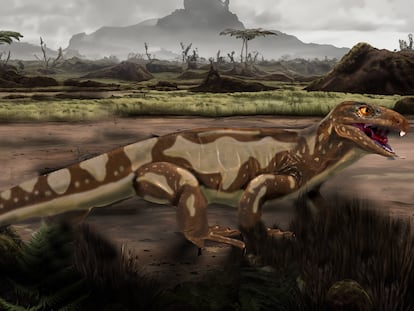Discovery of closest relative of ‘Tyrannosaurus rex’ sheds light on the mystery of these predators
The finding could clear up lingering questions about the origin and size of these enormous dinosaurs

The most popular dinosaur of all, Tyrannosaurus rex, was the biggest predator of its era and perhaps of all time, but for the scientific community it is still a mystery how these animals grew to be so gigantic. They weighed 10 tons, were 12 meters (39 ft) long and had enormous heads and teeth that could crush bones. The discovery of a new species of tyrannosaurid could clear up some of these questions. The analysis of a skull found in New Mexico, published today in Scientific Reports, adds a new relative to the family tree: Tyrannosaurus mcraeensis. It is the closest relative to T. rex and it sheds light on the diversity, origin and great size of these fearsome predators from the Late Cretaceous period.
“In paleontology, knowledge is furthered in two ways: by finding new fossils or by re-analyzing and reinterpreting previously found remains,” explains the paleontologist Luis Alcalá, director of the Science Park in Granada, in southern Spain, who did not participate in the finding. In order to identify this close relative of T. rex, the second method was used. A group of scientists from New Mexico used computer programs that can distinguish between various bones to classify species, and they discovered that a skull found in Hall Lake, New Mexico, had been attributed to a T. rex, but in fact belonged to a different dinosaur. The differences in shape and how the bones join together are subtle but significant enough to describe it as a different animal species, the authors say.
The new tyrannosaurus Mcraeensis — so called after the McRae formation in New Mexico, where many dinosaur remains have been found — might have lived between 71 and 73 million years ago, that is to say, five to seven million years before T. rex, according to the study led by the paleontologist Sebastian G. Dalman of the University of Massachusetts and his colleagues. Their conclusion is based on the location of the rocks and other remains in Hall Lake, where the skull was originally found.
Laramidia: The home of giant dinosaurs
“Although a lot is known about them, there are aspects that still lead to open debates about the origin of tyrannosaurids,” says Fidel Torcida, director of the Dinosaur Museum of Salas de los Infantes, who did not participate in the study. Within that controversy, one of the theories posited by paleontologists is that these large dinosaurs emerged in Asia and traveled to the Americas, while a second theory suggests the opposite, that they emerged in modern-day North America and moved towards Asia as their populations grew, to later go back to North America.
The discovery of Tyrannosaurus mcraeensis supports the North American origin theory, suggesting that the evolutionary line of tyrannosaurids began specifically in Laramidia, an island-continent that existed between 100 and 66 million years ago in what is today Canada, the United States and Mexico. Researchers also note that these dinosaurs lived in the south of the territory and were not always colossal in size. They evolved from hunters of small species during the Early Cretaceous to predators of large herbivores as they grew in size.
In a reduced region as islands are, it would not be odd if species were small or of a size matching their habitat. But this was not the case in Laramidia. On this island, “the temperature and the lack of predators may have caused herbivores to grow to dimensions such as those of giant dinosaurs like titanosaurs, ceratopsians or hadrosaurs”, explains Torcida. And as herbivores grew, so did the animals that preyed on them. This way, the authors suggest, they evolved to a giant size around 72 million years ago, to reach the recently discovered Tyrannosaurus mcraeensis and, millions of years later, give way to the famous T. rex.
Both Alcalá and Torcida think it is a positive thing that a new species of tyrannosaurid has been found. The finding adds diversity to the Tyranosaurini family and opens up new avenues of exploration, urging researchers to delve into the mysteries of ecosystems and the relationships between predators and prey in ancient times. Alcalá notes that Tyrannosaurus mcraeensis was initially classified as a T. rex, and wonders: “Could there be other different species of tyrannosaurs out there?”
Sign up for our weekly newsletter to get more English-language news coverage from EL PAÍS USA Edition
Tu suscripción se está usando en otro dispositivo
¿Quieres añadir otro usuario a tu suscripción?
Si continúas leyendo en este dispositivo, no se podrá leer en el otro.
FlechaTu suscripción se está usando en otro dispositivo y solo puedes acceder a EL PAÍS desde un dispositivo a la vez.
Si quieres compartir tu cuenta, cambia tu suscripción a la modalidad Premium, así podrás añadir otro usuario. Cada uno accederá con su propia cuenta de email, lo que os permitirá personalizar vuestra experiencia en EL PAÍS.
¿Tienes una suscripción de empresa? Accede aquí para contratar más cuentas.
En el caso de no saber quién está usando tu cuenta, te recomendamos cambiar tu contraseña aquí.
Si decides continuar compartiendo tu cuenta, este mensaje se mostrará en tu dispositivo y en el de la otra persona que está usando tu cuenta de forma indefinida, afectando a tu experiencia de lectura. Puedes consultar aquí los términos y condiciones de la suscripción digital.
More information
Archived In
Últimas noticias
From the White House to diplomatic gifts: Lego wins over adult fans, brick by brick
Kate Winslet makes her directorial debut: ‘There aren’t more female directors because we’re busy raising children’
ChatGPT fails the test: This is how it endangers the lives of minors
The late consecration of women artists in their 90s
Most viewed
- Families demand repatriation of bodies of Colombians who died in Ukraine: ‘This war is a slaughterhouse for foreigners’
- The low-cost creative revolution: How technology is making art accessible to everyone
- Liset Menéndez de la Prida, neuroscientist: ‘It’s not normal to constantly seek pleasure; it’s important to be bored, to be calm’
- Christian Louboutin: ‘Young people don’t want to be like their parents. And if their parents wear sneakers, they’re going to look for something else’
- ‘El Limones’ and the growing union disguise of Mexican organized crime











































